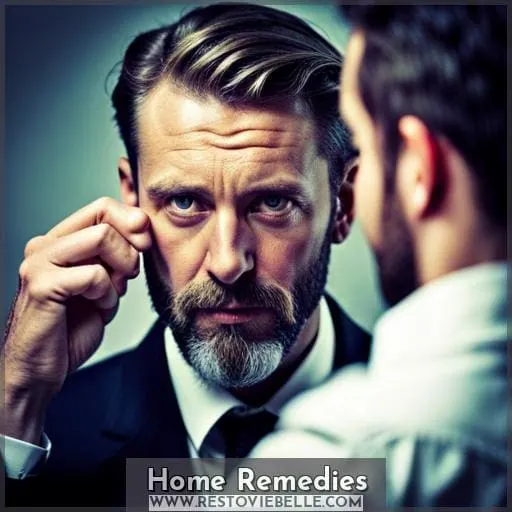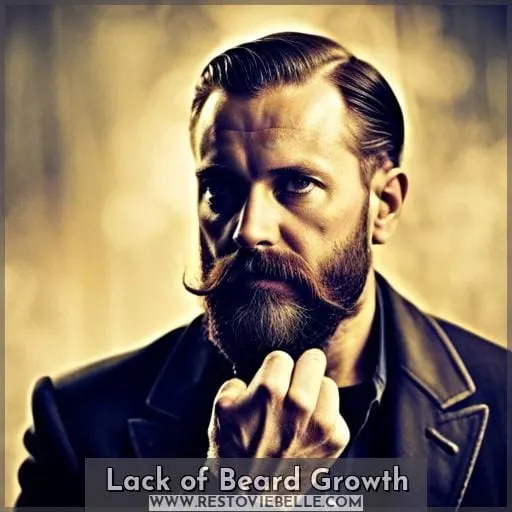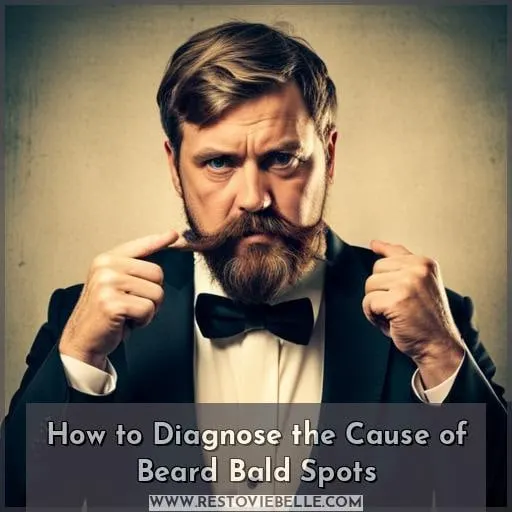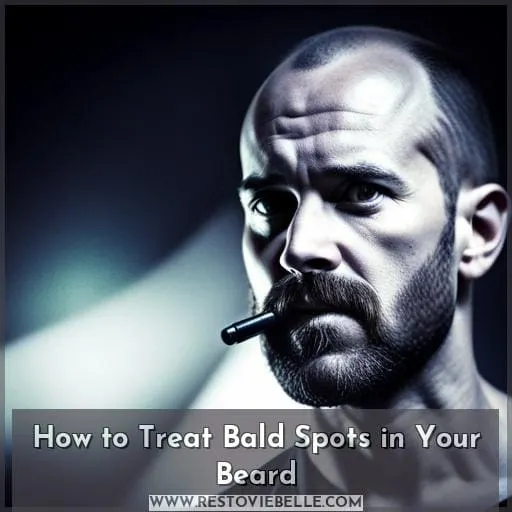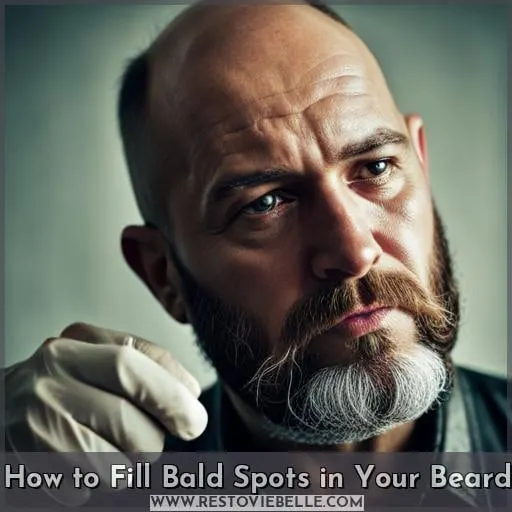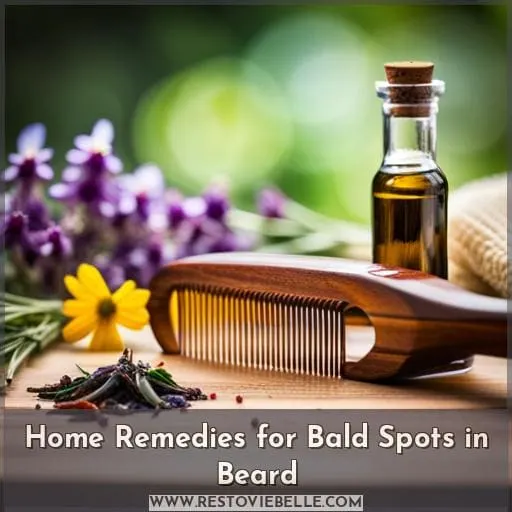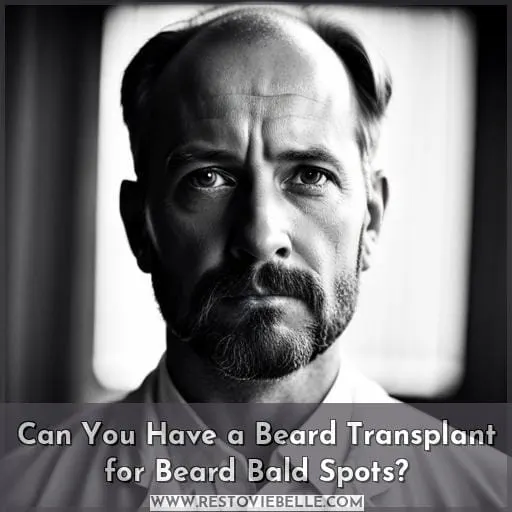This site is supported by our readers. We may earn a commission, at no cost to you, if you purchase through links.
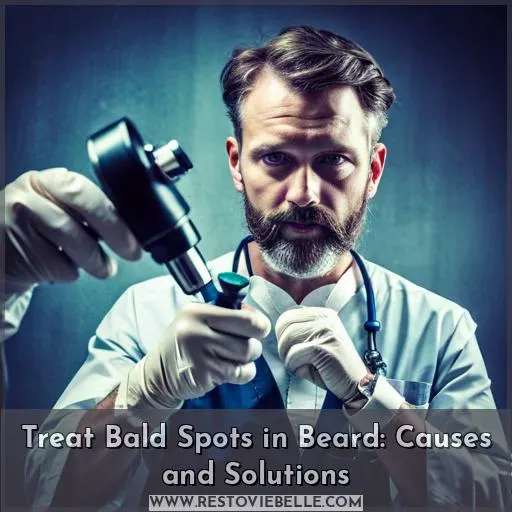 Looking to treat those frustrating bald spots in your beard? You’re not alone. Many men struggle with patchy facial hair and are searching for solutions.
Looking to treat those frustrating bald spots in your beard? You’re not alone. Many men struggle with patchy facial hair and are searching for solutions.
In this article, we’ll explore the causes of bald spots in your beard, including a lack of growth and conditions like alopecia barbae. We’ll also discuss effective treatments to help you fill in those gaps and achieve a fuller, more even beard.
Get ready to say goodbye to patchiness and hello to confidence!
Table Of Contents
- Key Takeaways
- Medications
- Home Remedies
- Lack of Beard Growth
- How to Diagnose the Cause of Beard Bald Spots
- How to Treat Bald Spots in Your Beard
- How to Fill Bald Spots in Your Beard
- Home Remedies for Bald Spots in Beard
- Can You Have a Beard Transplant for Beard Bald Spots?
- Frequently Asked Questions (FAQs)
- What vitamins and minerals promote healthy beard growth?
- How long will it take for my beard bald spots to fill in after starting treatment?
- Are there any side effects to using minoxidil on my beard?
- Is stress linked to beard baldness?
- Can I use concealer makeup on my beard bald patches as a temporary fix?
- Conclusion
Key Takeaways
- Corticosteroids and immunotherapy can help reduce inflammation and suppress the immune response attacking hair follicles in bald spots in the beard.
- Minoxidil and anthralin are topical medications that may stimulate hair regrowth and alter immune function in the skin to reduce bald patches in the beard.
- Home remedies such as garlic, Viviscal supplements, zinc and biotin supplements, and various oils can support hair growth and nourish thinning hair in the beard.
- The cause of bald spots in the beard can be diagnosed through considering family history, age-related changes, stress levels, autoimmune diseases, and consultation with a dermatology specialist who may perform a physical examination, scalp biopsy, or blood test.
Medications
You can try corticosteroids, minoxidil, diphencyprone, or anthralin to treat bald spots in your beard.
Corticosteroids like clobetasol or triamcinolone can reduce inflammation and suppress the immune response attacking hair follicles.
Minoxidil, available over-the-counter as Rogaine, may stimulate hair regrowth by widening blood vessels and opening potassium channels.
Diphencyprone is an immunotherapy that can train the immune system to stop attacking hair follicles.
Anthralin is a topical medicine that alters immune function in the skin to reduce bald patches.
While results vary by individual, these medications offer hope to regrow beard hair lost to conditions like alopecia areata.
Tracking progress monthly with photos can help determine if treatment is working or if adjustments may be needed.
Finding an effective medication alongside lifestyle changes may fill frustrating bald spots.
Home Remedies
To address bald spots in your beard, there are several home remedies that can be effective.
Garlic contains compounds that may support hair growth by stimulating blood flow. Crush several cloves of garlic into a paste and apply it to the bald patches, leaving it on for 30 minutes before rinsing.
Viviscal supplements contain marine proteins, vitamins, and minerals shown to nourish thinning hair.
Additionally, zinc and biotin supplements support healthy hair; aim for 30-50mg of zinc and 2,500mcg of biotin per day.
Oils like castor, almond, aloe vera, and coconut contain fatty acids and antioxidants that hydrate hair follicles.
Geranium essential oil boosts circulation when applied topically, which may encourage growth.
Commit to home remedies for at least 12 weeks to allow new hair to grow in fully.
Lack of Beard Growth
A sparse, patchy beard may be distressing. Let’s explore potential causes of your beard hair loss and appropriate solutions. Treatments will depend on determining if alopecia barbae, poor diet, medications, or other factors underlie your condition.
Alopecia Barbae
One potential cause for patchy beard growth is alopecia barbae, where your immune system attacks the hair follicles in your beard.
You’d notice sudden, circular bald patches that may be itchy or painful. This can lead to emotional distress as hair loss affects self-image.
Treatment options include corticosteroids to suppress the immune response, minoxidil to stimulate growth, and supplements like vitamin E. Making lifestyle changes to manage stress and improve diet supports healthy beard hair growth.
The recovery time varies depending on the treatment. Occasionally, the patches spontaneously disappear.
Discuss options with your dermatologist to find the right approach for your alopecia barbae.
Other Causes
After discussing alopecia barbae, you’d find other potential causes for a lack of beard growth relate to hormones, health conditions, and lifestyle factors.
Genetics play a big role – some men simply can’t grow a thick beard due to insufficient levels of DHT. Stress, poor nutrition, thyroid problems, vitamin deficiencies, and other illnesses can also inhibit beard growth.
Fungal infections like tinea barbae lead to itchy, red patches in the beard area. Lifestyle factors are important too – lack of sleep, smoking, and alcohol use can worsen hair loss. Focusing on healthy habits, taking supplements like vitamin E, and treating any underlying illnesses can help boost beard growth.
How to Diagnose the Cause of Beard Bald Spots
If you’re experiencing bald spots in your beard, it’s important to diagnose the cause so that you can find an appropriate solution. There are several factors that could contribute to beard hair loss, including alopecia barbae, age-related changes, stress, autoimmune diseases, and scarring.
Here are some ways to diagnose the cause of your beard bald spots:
- Consider family history: If there’s a history of alopecia or other hair loss conditions in your family, it may increase the likelihood of having alopecia barbae.
- Assess age-related changes: As men get older and hormones fluctuate naturally with age,may experience thinning or patchy growth in their beards.
By considering these factors along with any symptoms you may be experiencing such as sudden patchy baldness or circular patterns -you’ll have a better understanding of what might be causing your specific condition.
The next step would then involve consulting with a healthcare professional who specializes in dermatologyto confirm diagnosis through physical examination, scalp biopsy, blood test.
As always,treatment options should only commence upon official confirmation from medical experts.It’s essential not jump into conclusions but rather seek proper guidance from professionals before making any decisions regarding treatment methods.
Always remember,you deserve confidence,and working together we can find solutions tailored specifically for YOU!
How to Treat Bald Spots in Your Beard
When it comes to treating bald spots in your beard, there are options available depending on the underlying cause.
If you have patchy beard growth due to hormones or genetics, you can try:
- Minoxidil
- Microneedling
- Platelet-rich plasma therapy
For bald spots caused by conditions like alopecia areata, you may need:
- Corticosteroid injections
- Creams
- Other treatments to encourage regrowth.
Treatments for Patchy Beard Growth
You can treat patchy beard growth with minoxidil, platelet-rich plasma therapy, or low laser light treatment.
Using a beard roller or derma roller with minoxidil foam or Rogaine twice daily can stimulate hair follicles in patchy areas.
Taking finasteride orally and applying topical minoxidil foam directly to bald spots is another option.
Supplementing with biotin, fish oil, lavender, and rosemary essential oils can also help treat patchy facial hair growth.
Being consistent with these treatments is key – it can take 3-6 months to see results.
Experiment to find what works best for your beard’s bald spots.
Treatments for Other Causes
Having covered treatments for patchy beard growth, you’ll need to treat the underlying cause if your beard baldness stems from sleep deprivation, medication, or a fungal infection.
- Feel hopeless about ever regrowing your beard
- Worry you’ll never feel confident again
- Think you’ve permanently damaged your facial hair
- Fear your patchy beard makes you unattractive
But there’s hope. Work on getting quality rest, changing medications if possible, and using antifungals. Maintain healthy hair by eating nutritious foods with enough protein, vitamins and minerals like vitamin E, biotin and zinc.
If hair regrowth remains unlikely after chemotherapy, consider a beard transplant.
How to Fill Bald Spots in Your Beard
After determining the cause and seeking treatment for your beard bald spots, consider using temporary cosmetic solutions like hair fibers while regrowing your beard to conceal patches.
- Hair fibers – These are tiny keratin fibers that cling to existing hairs to create the appearance of fuller facial hair coverage. They come in shades that match different beard colors.
- Hair thickening spray – These sprays contain fibers as well as polymers that coat the hair shaft to make beards look thicker. They wash out easily.
- Beard micropigmentation – This procedure, also called scalp micropigmentation, tattoos tiny dots that mimic beard stubble onto the skin. It creates the look of a full beard and lasts 1-3 years.
- Beard growth supplements – Supplements with vitamin E, biotin, vitamin B, zinc, and magnesium may help stimulate beard hair regrowth over time. Consider beard growth vitamins or oils.
Home Remedies for Bald Spots in Beard
To address bald spots in your beard, try using simple home remedies. These remedies can help stimulate hair growth and improve the overall health of your beard. Some effective options include coconut oil, castor oil, aloe vera, rosemary oil, and onion juice.
| Home Remedies for Bald Spots in Beard | Benefits | How to Use |
|---|---|---|
| Coconut Oil | Moisturizes the skin | Massage onto the affected area before bed |
| Castor Oil | Promotes hair growth | Apply directly to bald patches twice a day |
| Aloe Vera | Renders soothing properties |
Apply fresh aloe vera gel on the affected area and leave it overnight
Rosemary Oil Stimulates blood circulation Combine with carrier oil and apply on bare patches daily
Onion Juice Boosts collagen production Mix onion juice with water or olive oil; apply twice weekly
These natural ingredients are readily available and can be easily incorporated into your grooming routine. However, it’s important to remember that results may vary from person to person.
maintaining good overall health by eating a balanced diet rich in vitamins A,C,E,Biotin,Zinc,Selenium,Iron,Niacin,Folic Acid , getting regular exercise,and managing stress levels will also contribute greatly towards promoting healthy beard growth.
Can You Have a Beard Transplant for Beard Bald Spots?
Those home remedies can help manage bald spots in your beard, but what if you want a more permanent solution?
Beard transplants are an extremely effective way to treat beard bald patches for some patients. They involve harvesting hair follicles from the back of the scalp and carefully transplanting them into the beard area.
The results can be transformative, with before-and-after photos showing significant beard hair regrowth.
However, beard transplants do come with some downsides to consider. The average beard transplant cost ranges from $4,000-$7,000. The recovery period lasts around 2 weeks, requiring meticulous aftercare to avoid complications like infections and poor hair growth.
And while most patients see excellent beard transplant results, they’re only appropriate for certain types of hair loss. Those with alopecia barbae or alopecia areata usually aren’t suitable candidates.
So weigh the pros and cons carefully with your dermatologist. When performed correctly for the right patient, beard transplants can fully restore patchy facial hair.
Frequently Asked Questions (FAQs)
What vitamins and minerals promote healthy beard growth?
Take supplements containing vitamins A, E, and B complex which support healthy hair growth.
Also ensure adequate intake of iron, zinc, and biotin which are essential for beard growth.
Massage beard area with oils containing vitamin E to stimulate follicles.
How long will it take for my beard bald spots to fill in after starting treatment?
After starting treatment for your beard bald spots, it can take some time to see results. The duration varies depending on the individual and the cause of hair loss. Patience is key as you wait for your beard to fill in.
Are there any side effects to using minoxidil on my beard?
Yes, potential side effects from using minoxidil on your beard include:
- Skin irritation
- Unwanted hair growth on other parts of your face or body
- Faster heart rate or low blood pressure
Carefully follow directions and speak to your doctor if any worrisome symptoms develop.
Is stress linked to beard baldness?
Yes, stress can contribute to beard baldness.
Prolonged stress may disrupt hormone levels, reducing testosterone production necessary for healthy beard growth.
While genetics likely play a larger role, mitigating stress through self-care could support your patchy beard.
Experiment with lifestyle changes before considering medical intervention.
Can I use concealer makeup on my beard bald patches as a temporary fix?
Yes, concealer makeup can be used as a temporary fix for beard bald patches.
It’s an effective way to camouflage the hair loss and create the appearance of a fuller beard.
Conclusion
So what’s a bearded fella to do about his patchy face fur?
While drugs and toupees won’t fill out those bare spots, taking action just might.
See a skin doc, try some proven home remedies like oils and gentle combing—but don’t get grabby with the scissors or give up on your lace.
Stay patient and keep grooming. If a full beard’s your goal, dedicated care and time could convince those scraggly strands to hang together into a hip masterpiece that frames your fine face.

